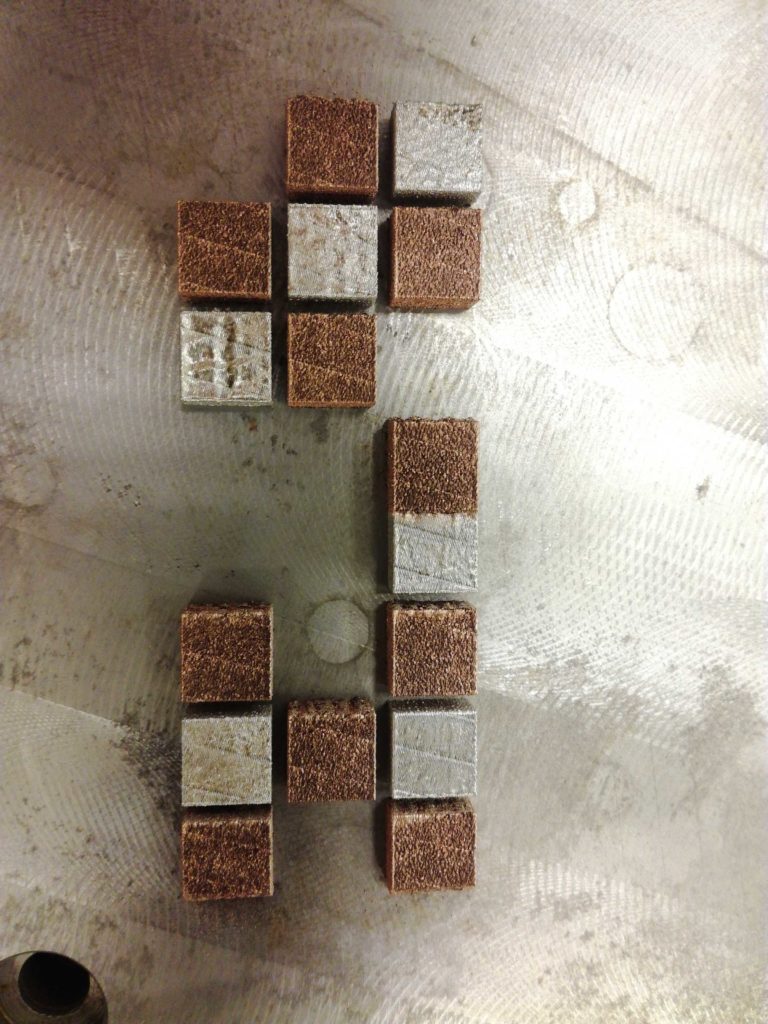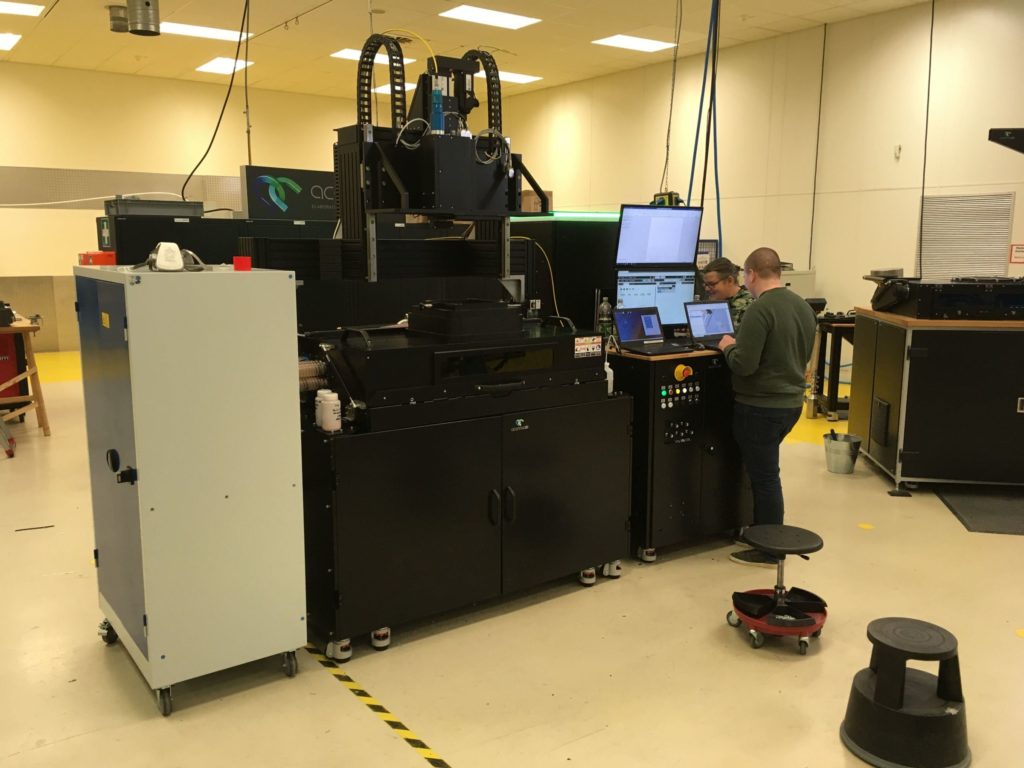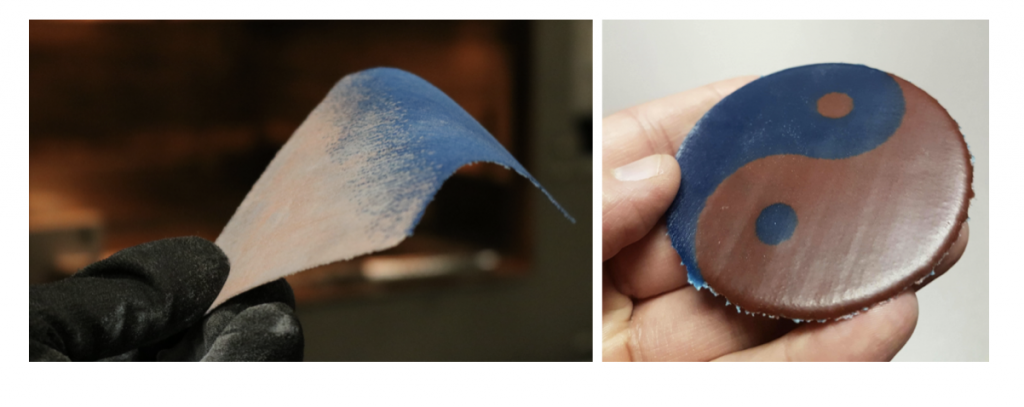After several years of research and a genius idea, Belgian startup Aerosint has accomplished its goal of multi-metal powder bed fusion (PBF). The company shared the news that, after printing separate components made of 316L stainless steel and CuCrZr (copper chromium zirconium) in a single build, it had successfully 3D printed a single part made up of the two materials. The fact that this was accomplished using a metal PBF system is no small feat.
For some time, one of the major advantages that directed energy deposition (DED) had over metal powder bed fusion was the ability to deposit multiple metal materials in a single build. Because DED does not rely on the use of a powder bed—in which fine metal particles are spread across the print area with each successive layer using a recoating blade or roller—multi-metal 3D printing is a simpler task. Different metal feedstocks are simply introduced to the deposition head, which uses different parameters, such as temperature, to melt the material onto the workpiece.
Aerosint was founded in 2016 with the goal of making it possible to fuse different materials within a single polymer or metal PBF system. The key was the development of a system that could replace the recoating process described above. Aerosint set about creating a method for depositing small “voxels” of powder point by point using rotating drums. In contrast to the one-size-fits-all method of recoating found in other PBF printers, Aerosint is able to control powder placement in a three-dimensional fashion.
As Kevin Eckes, R&D/Applications engineer at Aerosint, told us in an interview, “You can think of the powder images we create as physical versions of binary (i.e. black and white) images. So, while we can’t pattern truly continuous gradients, we can do dithered ‘digital’ gradients to form interfaces between two materials (see above, left). In our system, theoretically, you can pattern as many materials as you have rotating drums. In practice, there is, of course, a limit based on the machine size but 2, 3, or 4 drums per machine could be realized.”
As of 2018, the company had not yet developed a complete printing system but only had a rendering, according to President of T. A. Grimm & Associates Todd Grimm. With an €850,000 investment from Meusinvest Group, on top of its first round of funding, it was able to move closer to its goal.
Aerosint then partnered with Germany’s Aconity3D, whose machines would serve as the basis for Aerosint’s new powder deposition technology. The 316L-CuCrZr part was printed on Aconity’s Midi + L-PBF 3D printer. The part was 55 mm in diameter and 6.9 mm tall, specifically 174 layers of 40 microns each, and took about five hours and forty minutes to complete.
The component features interior CuCrZr channels with diameters of 1.7mm, highlighting the possibilities of multi-metal parts for that would combine the conductivity of copper with the durability of steel. Through a research consortium with Fraunhofer IGCV, Aerosint is already experimenting with 3D printing smart fluid-flow probes made from steel and copper.
Outside of this very specific application, it’s possible to imagine a number of applications for combining disparate metals. NASA used a DMG Mori hybrid 3D printer to combine copper with Inconel (a brand of nickel alloy) to create a rocket engine igniter that could reduce rocket engine costs by 30 percent, as separate copper and Inconel parts would not have to be brazed together.
In other cases, nickel could be used as a heat sink in a mold or die otherwise made of steel in order to allow the tool to cool off more quickly. You might also imagine combining copper with an inert material, such as cobalt oxide or iron phosphate, in order to create a battery.
As mentioned earlier, Aerosint is not limiting itself to metals alone. The company has already partnered with Solvay to perform multi-material polymer printing, as well as reduce the cost of selective laser sintering and print with high temperature materials, like PEEK.
Now that Aerosint has fulfilled its goal of printing with multiple metals at once using PBF, it will take significant time to ensure a stable, repeatable process; however, the long-term prospects for 3D printing are exciting. We may one day see multi-metal 3D printing as the standard as manufacturers employ their own versions of similar technology on their PBF systems.
(Images courtesy of Aerosint)
Subscribe to Our Email Newsletter
Stay up-to-date on all the latest news from the 3D printing industry and receive information and offers from third party vendors.
You May Also Like
3D Printing Financials: Fathom Struggles in Financial Quicksand During Critical Transition
Facing a year of key transitions and financial pressures, Fathom (Nasdaq: FTHM) has filed its annual report for 2023 with the U.S. Securities and Exchange Commission (SEC). The document outlines...
Latest Earnings Overview for Australian 3D Printing Firms Titomic and AML3D
Australian 3D printing manufacturing firms Titomic (ASX: TTT) and AML3D (ASX: AL3) reported their financial results for the period from July to December 2023, marking the first half of their...
3D Printing Webinar and Event Roundup: April 7, 2024
Webinars and events in the 3D printing industry are picking back up this week! Sea-Air-Space is coming to Maryland, and SAE International is sponsoring a 3D Systems webinar about 3D...
3D Printing Financials: Unpacking Farsoon and BLT’s 2023 Performance
In the Chinese 3D printing industry, two companies, Farsoon (SHA: 688433) and Bright Laser Technologies, or BLT (SHA: 688333), have recently unveiled their full-year earnings for 2023. Farsoon reported increases...



































